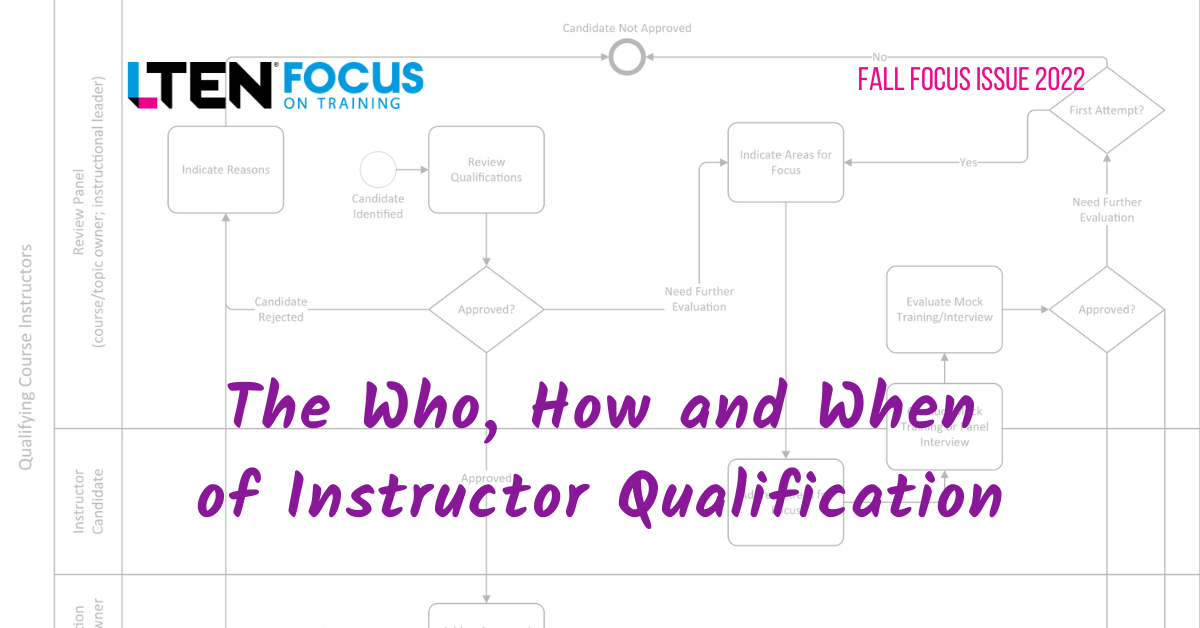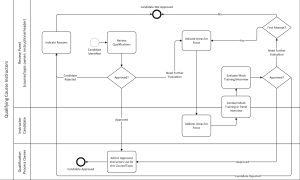
Here’s how to assess instructor candidates fairly and consistently
FEATURE STORY – By Tim Grenier
Two key components to great instructors are their subject matter expertise and strong facilitation skills. No doubt you’re already considering these as you identify new candidate instructors. But once you’ve identified a candidate, how do you fairly and consistently assess them along these two axes? This article will share some tools for that assessment.
Who Does the Assessing?
Because you’re concerned with two main areas of competence – subject matter expertise and facilitation skills – you’ll likely need multiple people to properly assess new trainers. One recommendation is to have “content owners” for each topic or course for which you’re qualifying instructors.
Separately, you’ll need someone who can evaluate and provide feedback on the candidate’s general ability to teach. Instructional design or learning and development leaders are great candidates for the latter role.
Establishing these roles and filling them before new instructor candidates are identified allows you to ensure consistency in your evaluations. It also allows you to designate someone to own the qualification process itself, which should include management of the database of qualified instructors for each course or topic, and facilitation of the interview scheduling and feedback sharing.
Now to the How
Consistency is again key here. If the rules for designating instructors are ambiguous, you might be set up for some difficult conversations about whether your process is fair. But you’re already off to a good start with the clear expectations and established roles for evaluating against those expectations. So what’s next?
One lesson learned is that not all evaluations require the same level of rigor. But what about consistency? Good question. There are ways to establish the process such that you can short-circuit it for candidates who are already established as imminently qualified, but still be fair to all candidates. The Figure 1 diagram shows such a process.
The first decision after reviewing the candidate’s qualifications enables three possible outcomes:
- Approved: The candidate is already a known expert in the subject matter and has already established their credentials as instructor.
- Rejected: The candidate is known not to have the requisite expertise or has been otherwise disqualified from instruction.
- Need Further Review: The candidate’s abilities are not yet known (either their teaching skills or their subject matter expertise or both.)
The “Need Further Review” path is where you’d set up your more formal qualification process, allowing both the topic owner and the instructional leader to further determine the candidate’s abilities. Common methods for conducting this review include having candidates mock-teach the course in the presence of the reviewers, submit videos of their teaching experience and answer typical student/attendee questions on the material.
Regardless of the decision to approve or not at this stage, it is recommended to include feedback for development based on your established expectations for instructors. It’s typical that everyone has some area where they can hone their skills further.
If the course owner and instructional lead are not ready to approve at this point, they’ll have to decide whether to provide a second opportunity after the candidate addresses their feedback, or to determine that the gap in ability is too wide for further consideration.
Tracking feedback and the decisions made at each step is important to the ongoing development of your instructors and to the credibility of the process itself.
When Do You Use This Process?
The most obvious case for qualifying a new instructor is that you have a new candidate who’s never taught this topic before. But there are other reasons you might have to repeat the process, even for instructors who are already qualified:
- The course material has been significantly changed.
- An existing instructor would like to teach a new topic they are not currently qualified for.
In the first example, you might have a slew of qualified instructors to “requalify” for the updated course. This can be incredibly cumbersome if you attempt to put them all through the full process individually.
One recommendation is to host information sessions where the course owner can inform the existing instructors on the changes and help them determine their readiness to teach the updated material. Those who need more help can go through the full process. Others might be fine once they familiarize themselves with the changes. Still others might determine that the materials have gone far enough beyond their expertise that they should come off the list of qualified instructors for that topic.
It might be apparent at this point that managing the database of who is qualified to teach what topics can become a challenge. This is where having a person who owns the qualification process is helpful. Recommended for this role is someone separate from the content expertise and who has responsibilities across your teaching program.
Wow That’s a Lot!
This process is admittedly pretty robust and demands some resources to adopt. You might want to leverage portions of it that apply most directly to your organization’s needs or tweak your existing process to integrate the whole scope.
You might even have something more involved than what’s described here. In any case, hopefully this example helps you think through some key aspects of your instructor integration process.
Tim Greiner is the senior director of USP education for the United States Pharmacopeial Convention. Email Tim at tag@usp.org.









